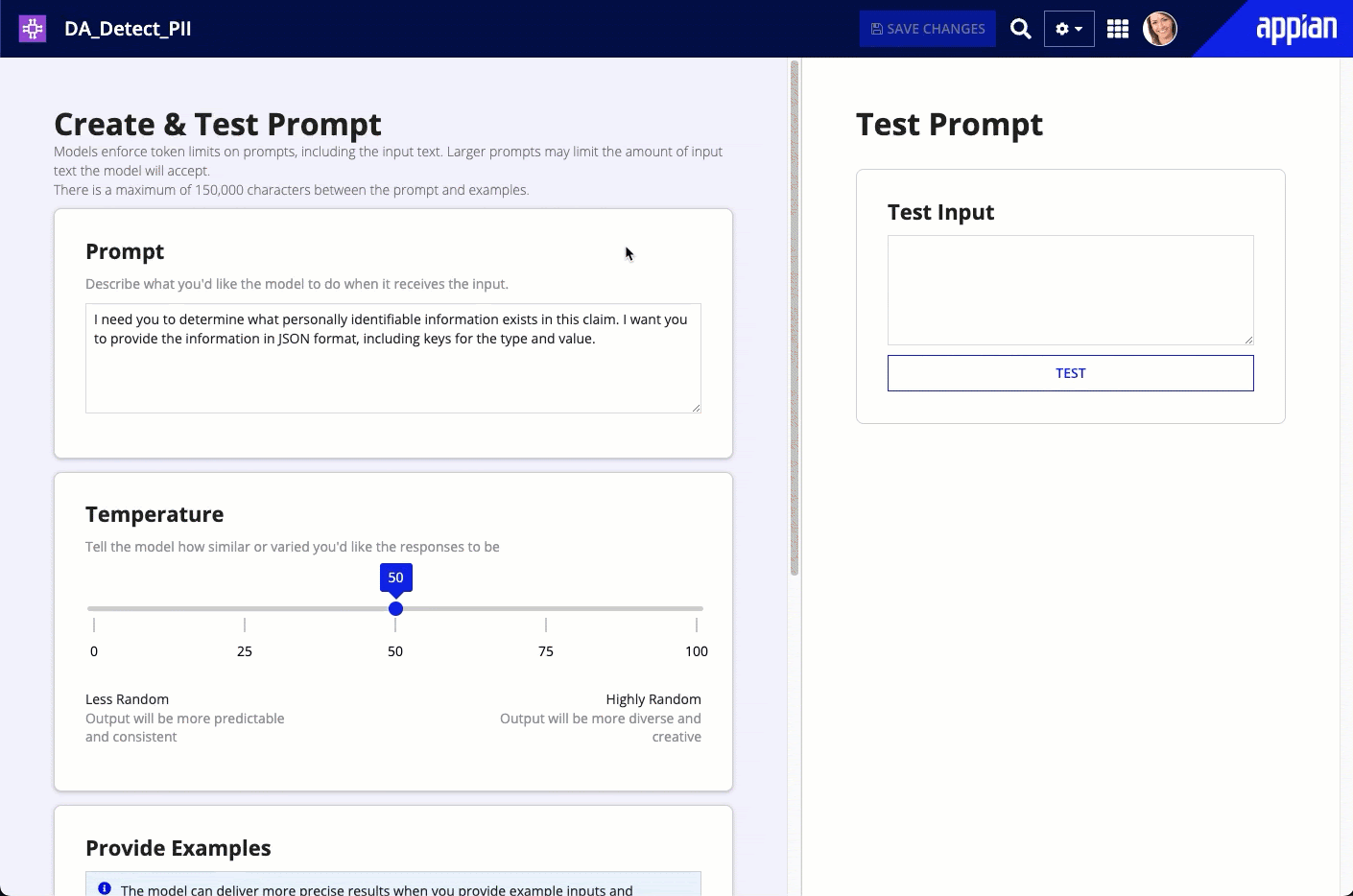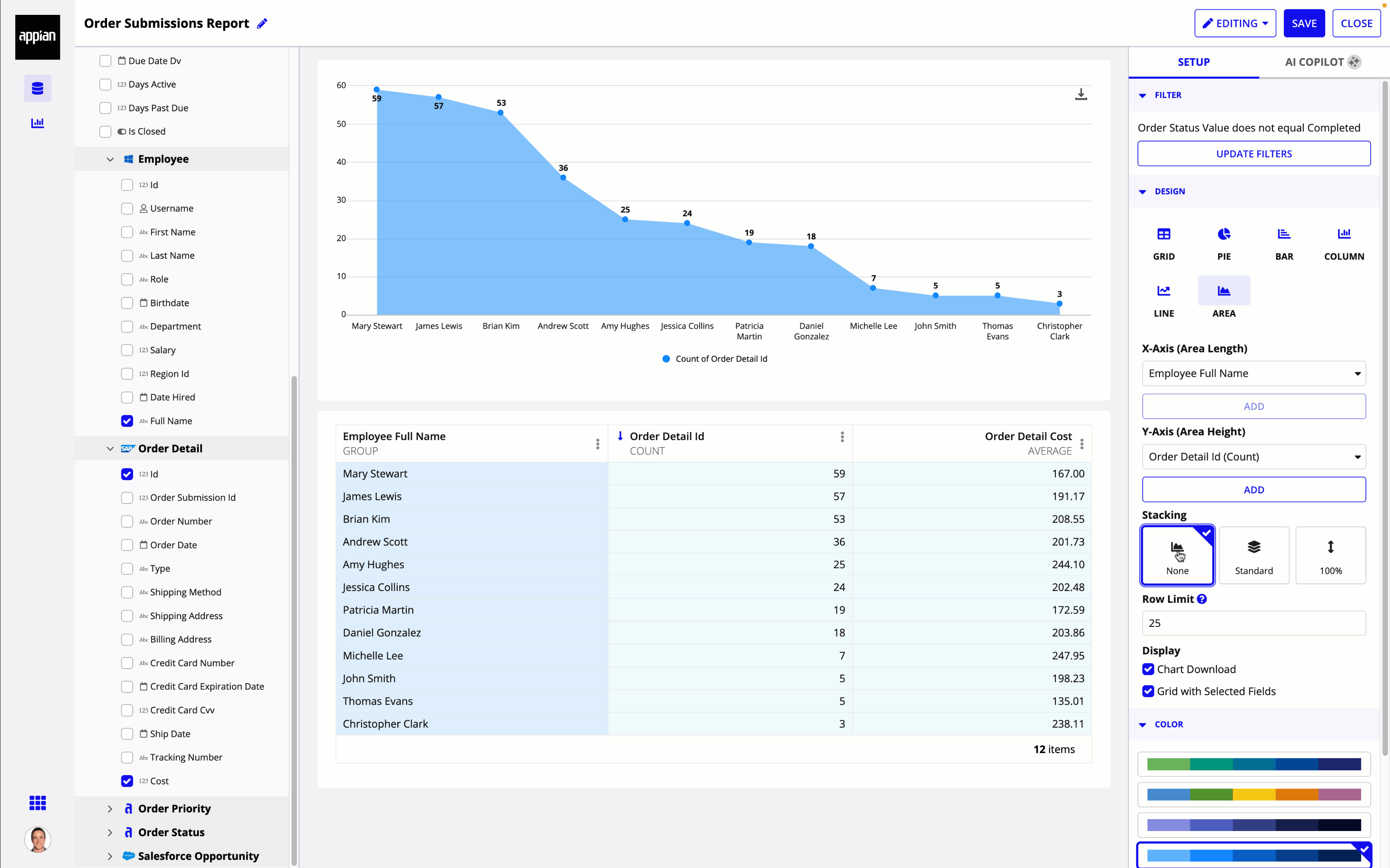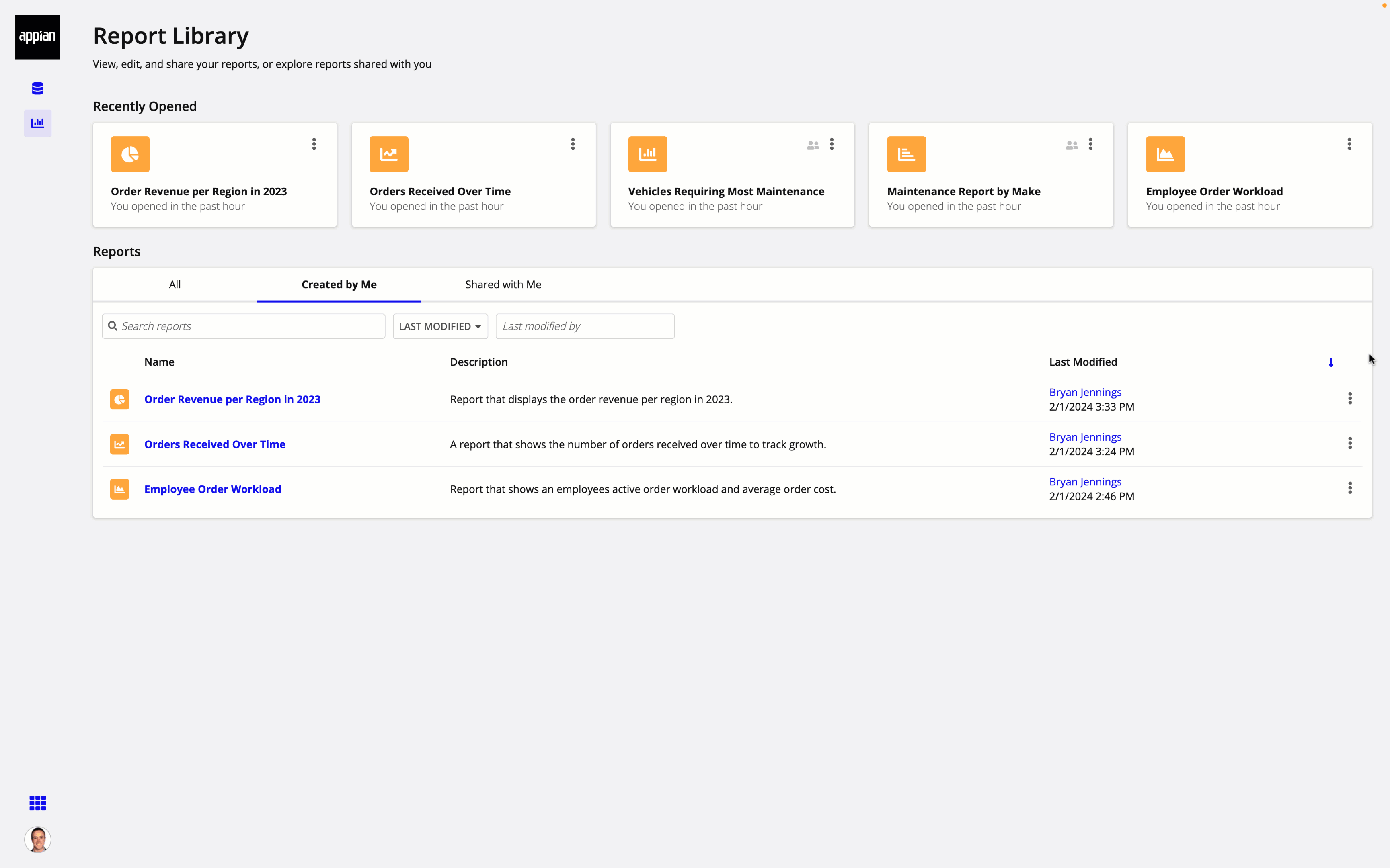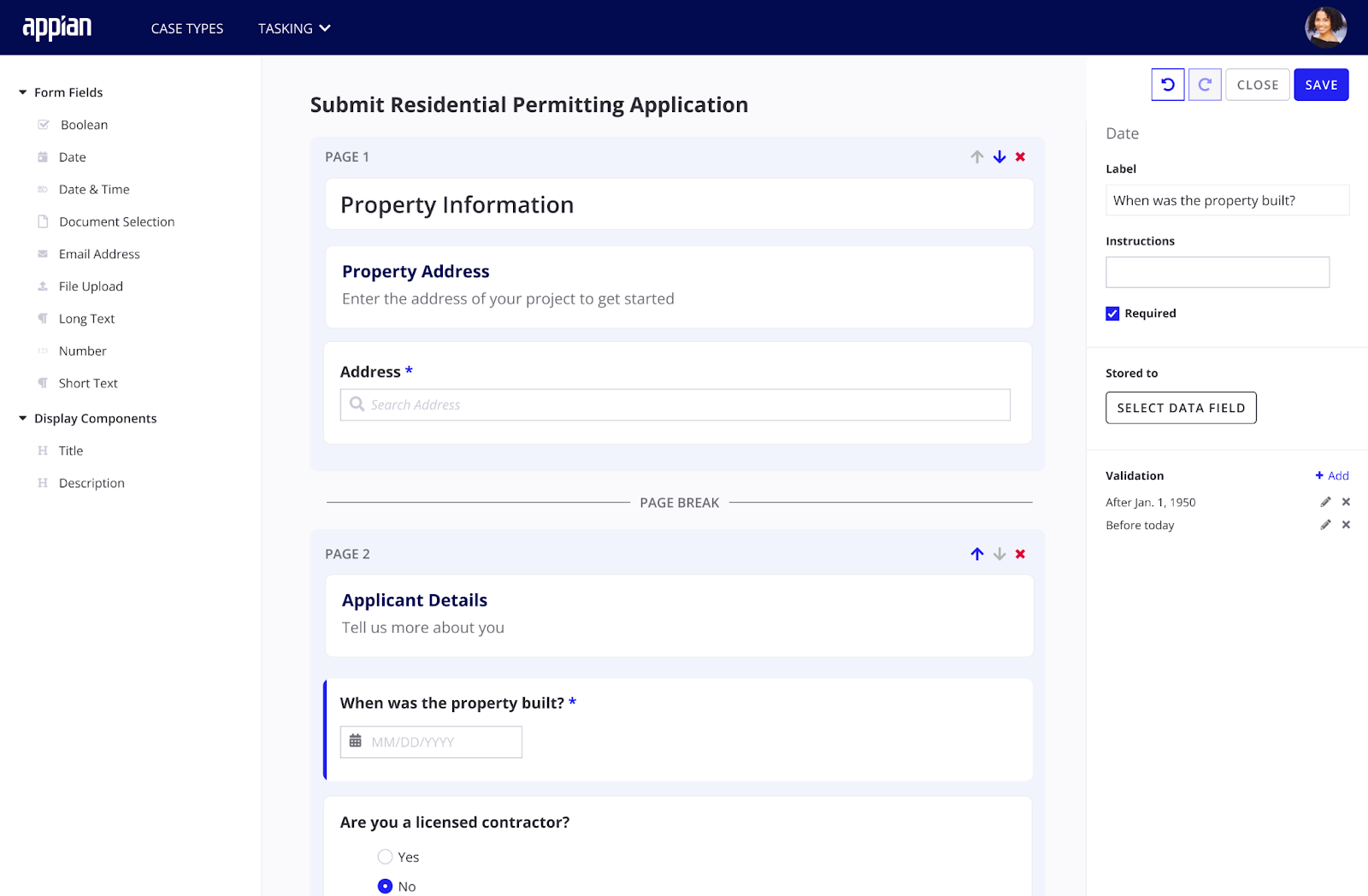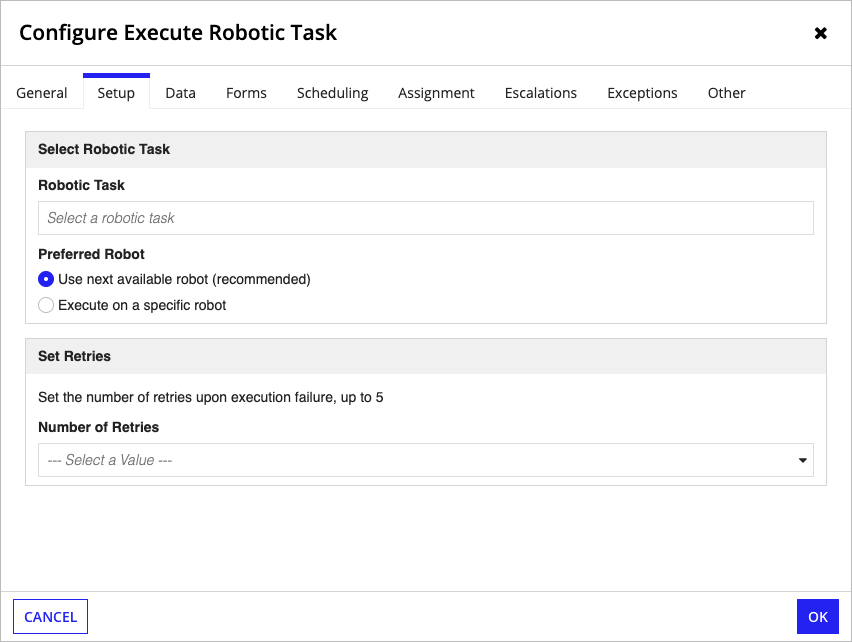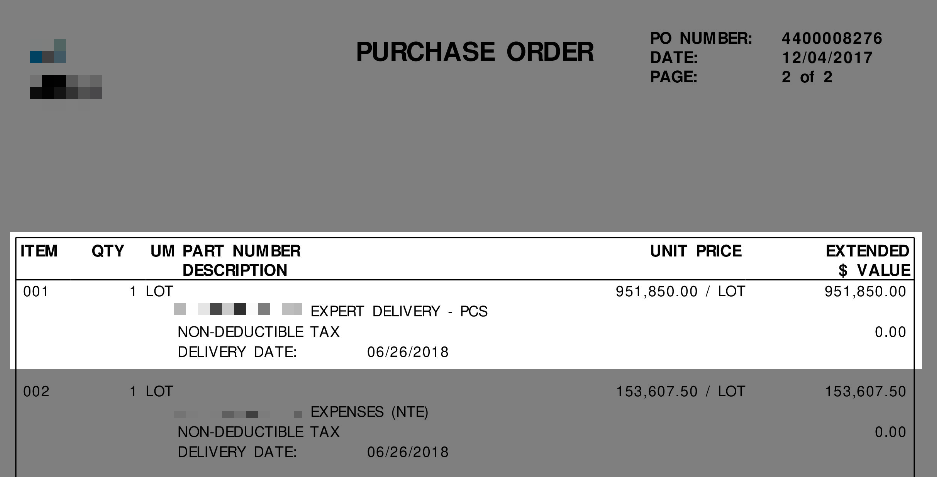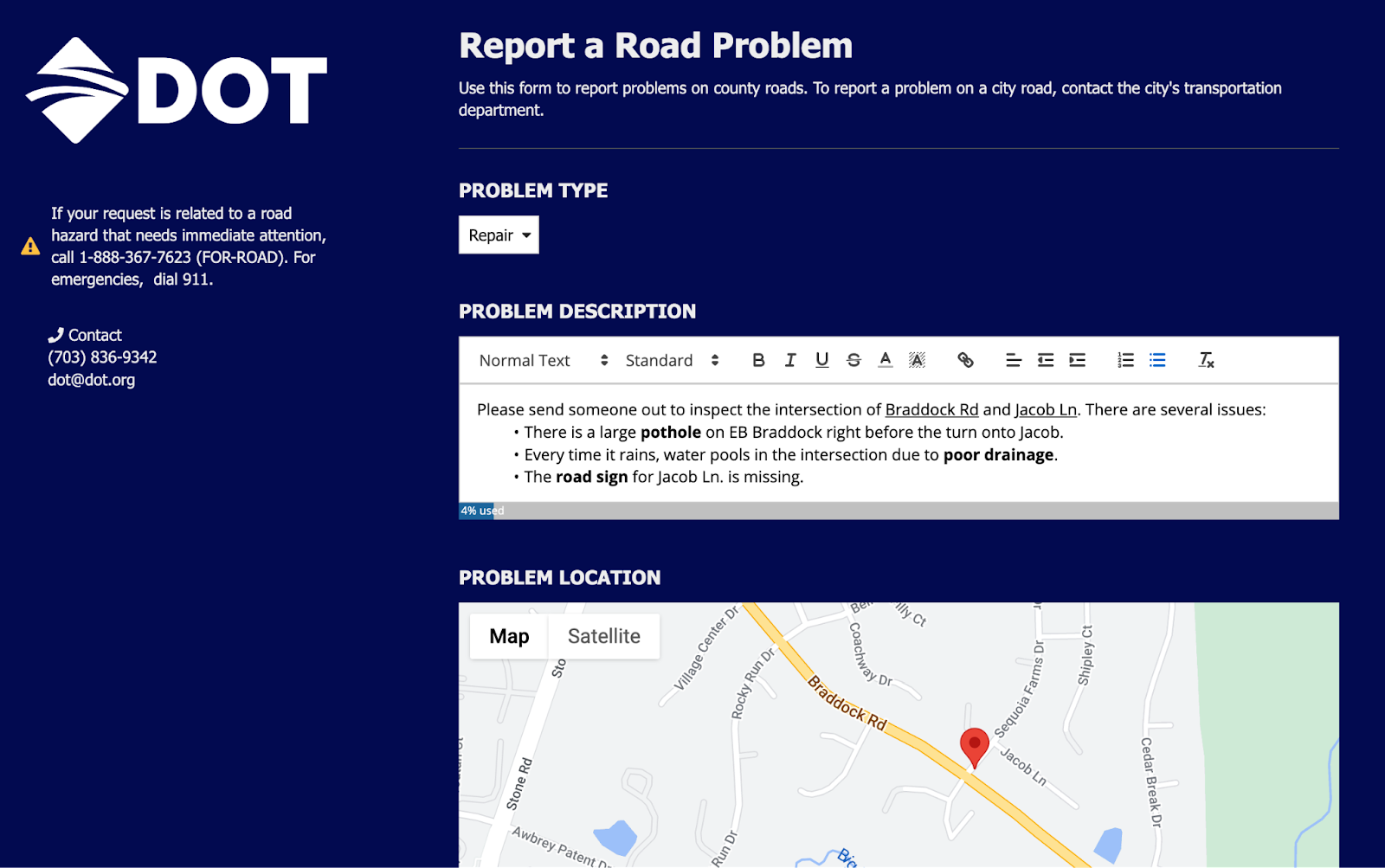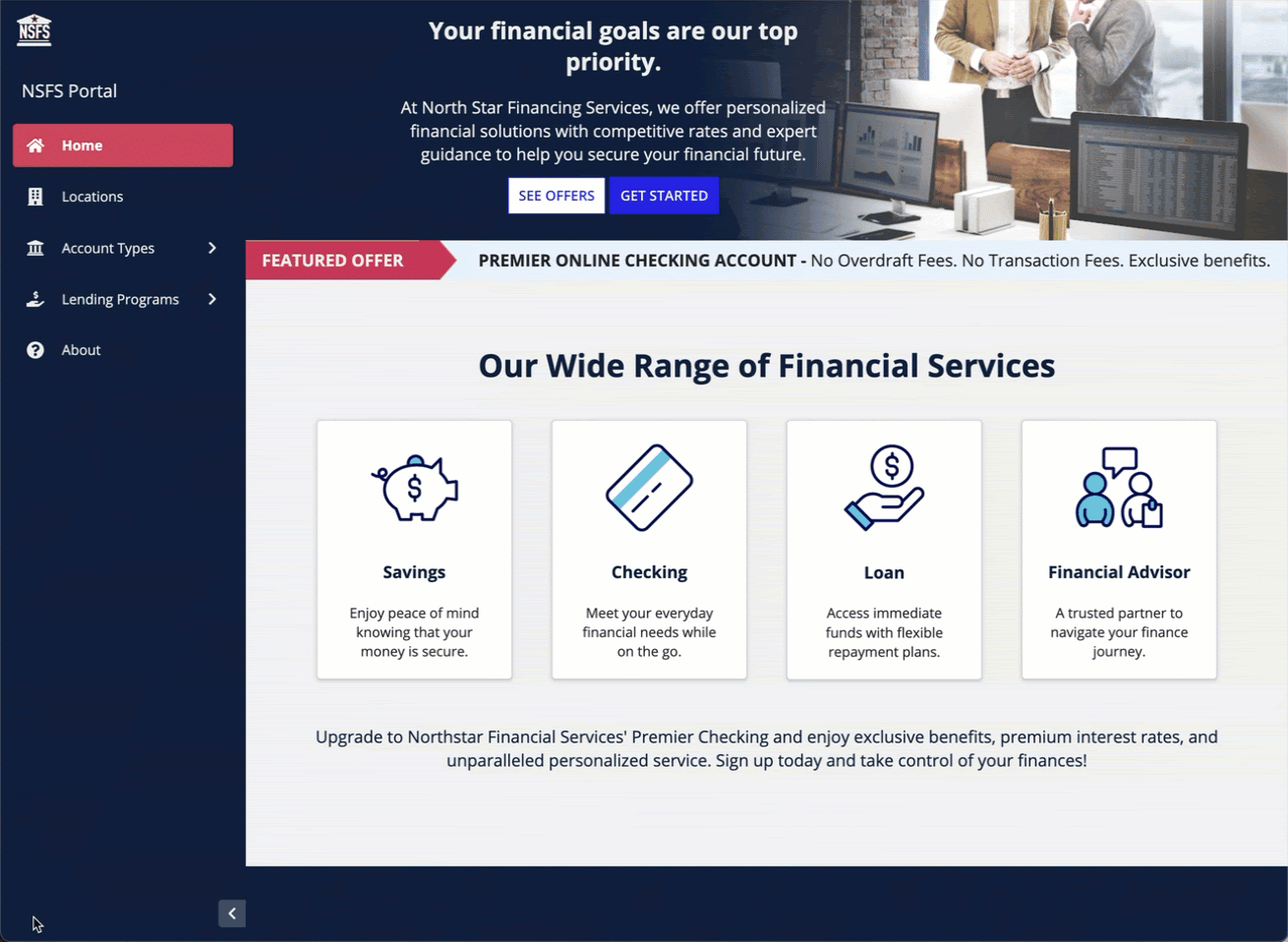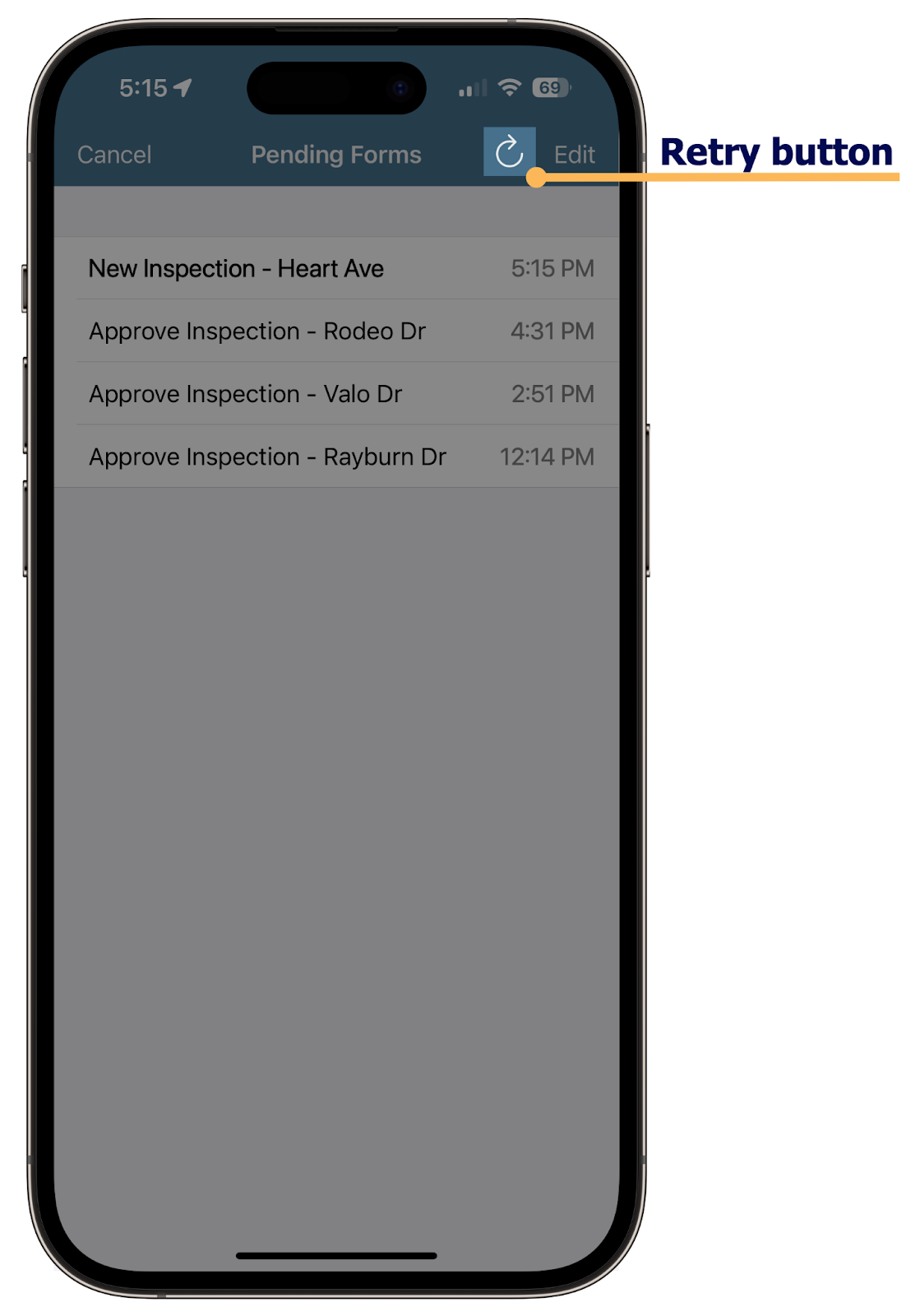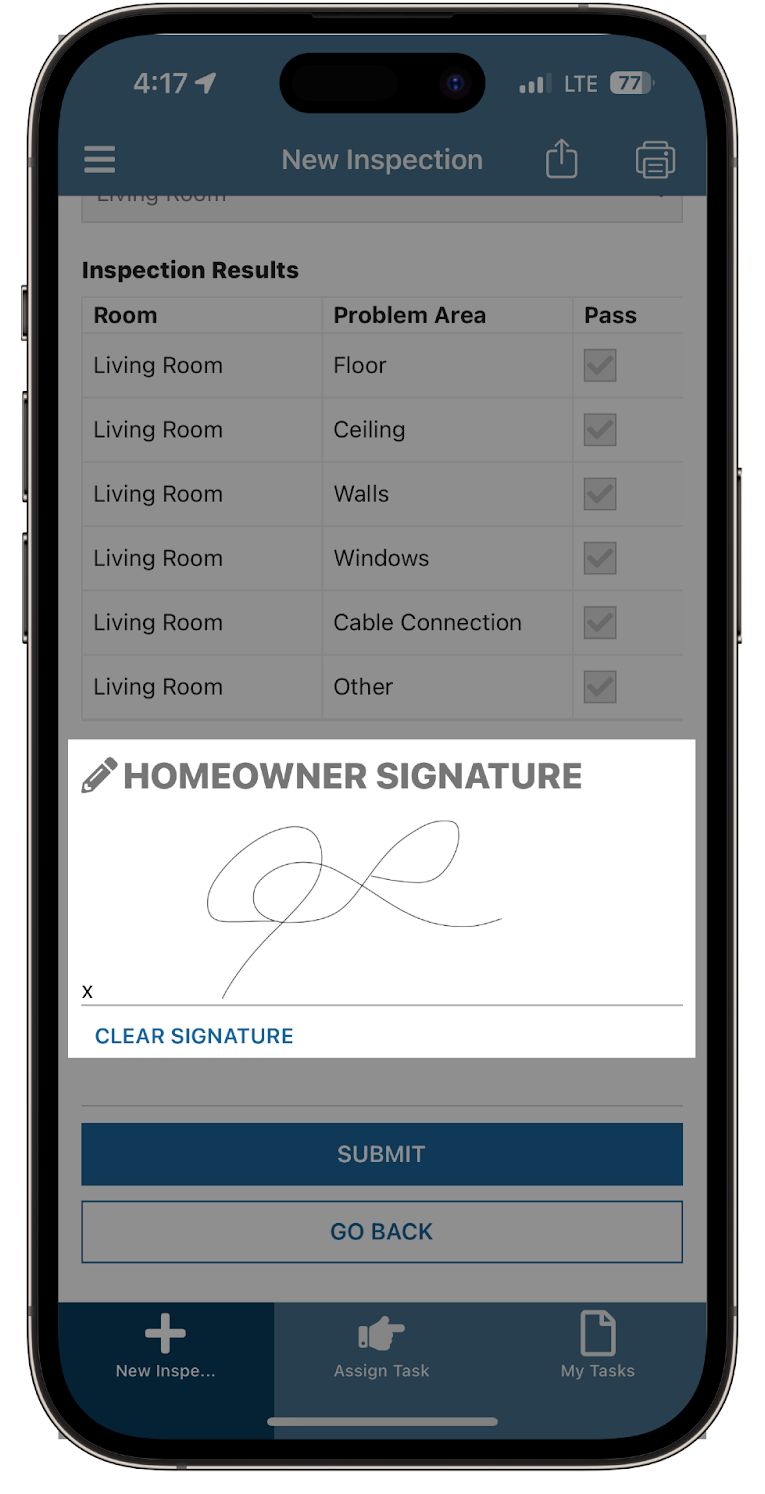Release highlightsCopy link to clipboard
This release introduces many new and exciting features throughout the product that make it faster to build enterprise-grade applications and easier for business users to gain valuable insights from their data. We're particularly excited to shine a spotlight on two standout features this release: the prompt builder AI skill and the ability to save and share reports built using self-service analytics.
Harness the power of generative AI throughout your processesCopy link to clipboard
This release, we're introducing a prompt builder AI skill that lets you tell a generative AI model what you want it to do in plain language, empowering you to use generative AI anywhere in your processes. Your instructions are then sent to the AI model, along with any additional text you want to analyze, extract, transform, or create.
For example, you can make claims processing faster and more secure by using AI to determine if those claims contain personally identifiable information (PII). Simply create a prompt builder AI skill and describe what you want the AI model to do. You can provide example inputs and output, such as a claim and a map of PII, so the model knows your requirements. Then, you can test the AI model directly within the skill to save valuable development time and feel confident the AI model performs as expected.
When you're ready to start using the prompt, add the Execute Prompt smart service to your process. Your prompt and input text are then sent to a private, generative AI model. Use the AI model's output however you use data in Appian processes - to display information, make decisions, write to the database, and more!
By transferring these time-consuming tasks to AI, your applications are more efficient and your workforce is more productive.
Allow users to explore and collaborate across your data fabricCopy link to clipboard
Last release, we previewed Appian's self-service analytics capabilities, empowering any user to explore and uncover AI generated insights about their data fabric. This release, we're elevating the self-service analytics experience by allowing business users to build more detailed reports that can be saved and shared across your organization.
Now, users can dig deeper into their enterprise data with additional reporting configurations. They can quickly create complex views of their data by adding multiple fields to any bar, column, line, or area chart.
Charts can also be paired with a grid to allow for more interactive configuration changes and to give users greater visibility into the report data. But it's not just more detailed reports, users can also customize the color scheme of their reports to complement their company's branding.
Once they finish building out their report, users can save the report for future exploration, download their chart as an image, or export their grid to Microsoft Excel. All saved reports are easily accessible from a new Report Library. Here, users can view, duplicate, and share their reports, or view reports shared with them.
With self-service analytics, users can seamlessly collaborate and share their insights with the people who need them.
Create case management apps faster than ever with Case Management StudioCopy link to clipboard
This release, we are excited to announce Case Management Studio, an out-of-the-box suite of applications that facilitate rapid development of case management apps and allow users to manage each part of your case process. Case Management Studio not only enables your case workers to perform their core responsibilities, but also allows business users to maintain and customize your case management workflows in a central application.
Case Management Studio has two parts, Workspace and Studio.
Workspace provides users with everything they need to quickly and efficiently resolve cases—total visibility into case status, workflow visualization, tracking, auditing, and more.
In Studio, your users have complete control over the case management process and, using our simple and intuitive no-code tools, they can make workflows that perfectly fit your business needs. Studio enables your users to easily create and configure every part of the case workflows, from key data, to reusable tasks, to custom forms.
Create custom case categories and select default fields that contain key data to use across the category. Each new case type in the category will then come with those fields already included—no extra steps necessary!
Customize your workflows with configurable tasks, which can be created, edited, rearranged, removed, and reused. Once you've created a task, you can then add it to a task block. Task blocks allow you to create flexible paths for each workflow that can be used again and again.
Create easily configurable intake and edit forms for case types directly in Studio, using a sleek and simplified version of Appian's classic drag-and-drop. Need even more customizations? No problem! You can always edit the forms in Designer, using the interface experience you know and love.
You can also extend the functionality of Case Management Studio with the Report Builder modules, which allow you to enable users to create and share configurable reports or dashboards.
AutomationCopy link to clipboard
Automation combines people, technologies, and data into a streamlined and unified workflow. Tackle a variety of business challenges so you can free up your human workforce to focus on more impactful work.
This release, we're excited to present enhancements that integrate robotic tasks directly into your process models, boost the security and management of your robots, streamline the extraction of table data using robotic tasks or AI Skills, and introduce a new feature in the Process Modeler.
Streamline integration of robotic tasks into your process modelsCopy link to clipboard
Robotic tasks are now seamlessly integrated into your process models. A new version of the Execute Robotic Task smart service lets you configure robotic tasks directly in the process node, eliminating the need for connected systems or integration rules.
Manage robots and robot pools with easeCopy link to clipboard
Get ready for a game-changing update to the Operations Console! We've launched an enhanced robot management dashboard, expertly designed with IT operations managers and efficiency in mind. Seamlessly oversee and adjust your robot workforce without ever having to access Appian Designer.
Enhanced robot security and authenticationCopy link to clipboard
We're aligning Appian RPA with the latest industry security standards by automatically pre-signing all agents. Additionally, robot keys can now be used for agent authentication on Mac and Linux platforms. We're ensuring that your robot workforce is not only more secure but also more versatile and seamlessly integrated across diverse operating systems.
Easy troubleshooting with formatted process historyCopy link to clipboard
In the process modeler, we've improved the look and feel of the Process History tab so you can more easily audit updates to record data, including field level changes. You can quickly view a formatted list of your process data at a glance, or expand the view to see the full details of any variable. With formatted process data, you can easily read your process data, troubleshoot potential issues, and ensure the proper functioning of your automations.
Extract data from web tables using task recorderCopy link to clipboard
The Get table values low-code action is now part of the task recorder, making it easy to quickly extract data from HTML tables. Use the task recorder to extract the data you need from an entire table and save it directly to a robotic task variable. Say goodbye to manual entry and intricate coding—it's all about efficiency and ease.
Extract data from tables and checkboxes more accuratelyCopy link to clipboard
Continuing the theme of making it easier to extract data from tables, we've enhanced the document extraction AI skill to more accurately extract data from tables and checkboxes. This update improves your ability to extract structured data from a variety of document formats. For example, you'll see much better extraction accuracy for tables in scanned docs, tables with complex or multi-line rows, and hand-filled checkboxes.
Tip: To confirm your environment takes advantage of these enhancements, contact Appian Support.
Quickly train a new document extraction model using previous datasetsCopy link to clipboard
We've made it easier to continue training a document extraction AI skill. Now, you can start training a new model based on a model you've trained previously. Your new model has the same sample documents, fields, and labels you added before, saving you time. With this jump start, you can go on to add and remove documents, fields, and labels to train the new model.
Data fabricCopy link to clipboard
Appian's data fabric stitches together data from multiple systems into a single, secure data model, while keeping your data where it is. This release, we're excited to share that you can now control which record types are available to business users, seamlessly keep record data available at high volumes, and sync your data faster.
Control which record types are available to business usersCopy link to clipboard
As we continue to empower business users to explore and analyze your data fabric, we're also giving you more control over which data is available to those users.
From the new Workspaces page in the record type, you can specify if the record type should be available as a dataset in self-service analytics or as a record in Tempo. To help get you started, any record type available in Tempo is also available in self-service analytics.
When you make a record type available to users, we'll automatically enforce your record type security and record-level security, ensuring that only the right users can access the right data. With this extra layer of security, you can be confident that your data is always secure, no matter where it's viewed.
Keep record data available at high volumesCopy link to clipboard
We know that as your business grows, the volume of your business data does too. That's why we're introducing a new sync option that dynamically syncs your latest 4 million rows of data—preventing the record type from ever exceeding the row limit.
Once you enable the setting, simply select a field like lastModified to specify which data is the latest. Then, whenever a full sync occurs, Appian manages which data is synced so you and your users always have access to the most recent data.
View changed record data at a glanceCopy link to clipboard
We've updated the way record data is shown throughout the design experience. Now, Appian highlights changes to your record variables with inline icons.
Any time you test an expression, interact with an interface, or examine a process instance, the changes to your record data are easier to spot. Seeing this at a glance can also help you understand what data the Write Records smart service has changed, enabling you to build quickly and confidently.
Monitor and improve queries to your recordsCopy link to clipboard
Appian's data fabric lets you unify millions of rows of data from multiple sources throughout your organization. Now, you can quickly view how and where that data is queried throughout your applications, so you can more easily understand and optimize your queries to your record types.
From the new Query Performance tab, you can view details about every record query to your record type—all in a centralized place. At a glance, you'll see when a record query occurred, how long it took, the user involved, and which interface rule or component was used to run the query.
More flexibility in how you write recordsCopy link to clipboard
Writing data is an essential part of application development, so we've enhanced and streamlined the Write Records smart service experience based on your feedback.
The output now preserves all of your input data so that you can keep using it in your process without re-querying your record types. Just replace your existing nodes with a new Write Records node, and you're ready to go.
But the benefits don't stop there! You can use the Write Records smart service in more scenarios where the database configuration can't be modified. Specifically, any source field—not just foreign keys—can be not nullable. And, you can now write to a base record type even when related record types are set to not allow writes. The smart service will just skip over anything that can't be written. This empowers you to build faster and provides you with more options to manage your data.
Full support for a!queryRecordByIdentifier in portalsCopy link to clipboard
This release, we've made a!queryRecordByIdentifier() fully compatible with portals! This allows you to query both unsynced and synced record types in a portal, so that you have the records you need wherever you need them. Not only that, you'll notice faster queries to your records when you use a!queryRecordbyIdentifier() across your applications.
Easily create system-specific JDBC connected systems templatesCopy link to clipboard
This release, creating Custom JDBC Connected System objects is a breeze with fewer clicks.
Now, after your JDBC driver is successfully deployed, a system-specific JDBC connected system template appears in the Create Connected System pick-list dialog. This allows you to quickly locate and connect to your desired source system with fewer configuration steps.
Support for PostgreSQL 15 and SQL Server 2022Copy link to clipboard
We're excited to add two new supported databases: PostgreSQL 15 and SQL Server 2022. These databases are supported as both Appian data source and business data sources.
With the addition of SQL Server 2022, you'll be able to leverage more enhancements related to security, performance, and data replication to and from Azure. And, PostgreSQL 15 offers substantial sorting performance improvements. Additionally, the default JDBC driver for PostgreSQL has been upgraded from version 42.4 to 42.7.
As always, Appian continues to find new ways to unify your enterprise data in our powerful data fabric.
Total experienceCopy link to clipboard
Appian provides a total experience that engages internal and external users across web and mobile, and allows you to build beautiful interfaces with drag-and-drop design tools. This release, we're excited to share that you can now use some of the most popular component plug-ins in your portals, test localized interfaces directly in an interface object, and leverage a brand new KPI component.
Sites and portalsCopy link to clipboard
Appian Portals achieves FedRAMP certificationCopy link to clipboard
We are excited to announce that FedRAMP-compliant portals are now available to many of our customers. Appian Portals received FedRAMP Moderate certification as of January 2024.
FedRAMP certification is the gold standard of security and risk assessment for cloud technologies and federal agencies. This certification makes Appian Portals a trusted choice for federal agencies and indicates an elevated level of security that is beneficial for all organizations using portals.
We will be rolling out compliant portals to FedRAMP customers throughout 2024.

Extend your portal capabilities with three of the most popular component plug-insCopy link to clipboard
We're expanding the capabilities of your portals by allowing you to leverage some of the most popular component plug-ins in the App Market. Starting this release, the Rich Text Editor, Google Maps, and ESRI ArcGIS Map components can all be used in portals.
The Rich Text Editor plug-in empowers users to make their content easier to read and understand using common text formatting. The Google Map and ESRI ArcGIS Map plug-ins enable powerful interactive map features. These plug-ins bring modern functionality to your portals and allow you to create richer user experiences.
Tailor record links to open in specific site pagesCopy link to clipboard
We're bringing you more control when linking to records. Now when you use a!urlForRecord(), a!recordLink(), or a!userRecordLink(), you can use the new targetLocation parameter to open a record link in a specific site page.
With the evolution of a!urlForRecord(), you can now bring users to a specific record view and site page. You can also tailor the record link components to bring users to a specific page, or even an entirely different site. These new capabilities ensure your users will have an intuitive and seamless navigation experience.
Use the bold sidebar layout in portals, now with collapsibilityCopy link to clipboard
Last release, we delivered the new sidebar layout for sites to help you create modern looking UIs with sleek navigation options for your users. Now, we're adding that same sidebar layout to portals! This easily configurable and natively responsive layout gives you the same branding options as the header bar layout, while providing more flexible design for portal navigation and style.
Not only that, but the sidebar layout is now collapsible in both sites and portals with no additional configuration necessary.
Develop portals faster with new design guidanceCopy link to clipboard
As part of our ongoing efforts to streamline portal development, we're introducing new design guidance for portal interfaces and rules. When you're developing a rule or interface that is used in a portal, the new guidance tells you if you're using functions and components that aren't supported in portals. The guidance even points out the location of the incompatible functions for effortless troubleshooting. This results in a smoother experience when creating portals, speeding up the development of your next app.
Quickly find and resolve errors affecting your portalsCopy link to clipboard
No more sifting through log files to understand why users are seeing errors in your portal. Just click an error count in the Portal Monitoring tab to view the error details for each portal and help you know exactly where to look when troubleshooting.
This enhancement to the Portal Monitoring tab makes it easier than ever to create and maintain portals that are responsive, reliable, and available to all your users.
Streamlined service account creation in portalsCopy link to clipboard
We've made it even easier to set up service accounts in portals). Now, when creating a service account within the portal object, you can directly select groups to add the account to. This streamlined workflow eliminates the need to navigate away from the portal object, reducing the time and effort involved in assigning groups during portal design.
Enjoy a more modern look with the restyled user menuCopy link to clipboard
We've restyled the user menu to give your sites a more modern look. We have also updated the default profile photo in Latin-language locales to show the user's initials, instead of the generic profile icon.
And don't worry, you won't have to configure a thing! These updates are automatically applied when you upgrade.

LocalizationCopy link to clipboard
Easily test interfaces in any supported localeCopy link to clipboard
This release, you can easily test and preview interfaces in any Appian supported locale while you develop. Now, there's no need to switch your user locale settings—just click the dropdown and select a locale to preview your interface in.
The locale preview lets you see not only the value of your translation strings in the selected locale, but the values of any localization functions, like a!currency() or date and time functions for that locale as well. With an immediate and accurate preview of your entire interface at your fingertips, you can easily make informed design decisions and quickly develop reliable localized applications.
Add dynamic values to translation stringsCopy link to clipboard
This release, you can embed dynamic values like usernames, dates, and times into static translation strings, providing your users with more information and higher quality translations.
These dynamic values, called translation variables, can be the value of a function, rule input, or variable. They can be rearranged anywhere within a translation string so that they seamlessly fit into the unique grammar structure of any locale. You can even use rich text styling on translation variables, opening up a wider range of design possibilities in your interfaces.
And, we can automatically detect these dynamic values in an interface. This means that you can use bulk generate to convert them into new translation strings complete with translation variables in just a few simple clicks!
Manage duplicate translation stringsCopy link to clipboard
Maintaining your translation sets is now easier than ever with a new filter to help you identify duplicate translation strings. Within a translation set, you can filter for duplicates based on the primary locale to help you decide when to create new strings or use existing ones. Get insights into your translation set and streamline your use of existing translation strings fast!
Import translation strings asynchronouslyCopy link to clipboard
Now, translation strings import asynchronously, so you can get back to work on your application while we update the translation set—no wait necessary!
Quality of life translation set improvementsCopy link to clipboard
We've also made a few small improvements to your translation experience. You can now sort translation sets faster and easily compare translation string versions across environments. Take advantage, too, of enhanced performance when generating translation strings from an interface and our increased limit of translation strings per translation set—from 1.5k to 5k! These improvements will save you time during development and deployment, as well as better the overall health and performance of your localized applications.
InterfacesCopy link to clipboard
Build data-packed interfaces with the new pane layoutCopy link to clipboard
We're introducing a fresh, new way to display your enterprise data in your interfaces. The pane layout allows you to seamlessly present complex information, giving you up to three independently scrollable areas to display both content and context.
We're opening up a new range of design possibilities so that you can provide your users with interfaces tailored to their tasks. From message inboxes to forms shown alongside business data, you can build layouts that give users the choice to keep some information visible in one pane while working in the adjacent pane.
This flexibility lets users spend less time navigating between separate interfaces to get the data they need and empowers them to complete their work more naturally.
Showcase vital business metrics with the KPI componentCopy link to clipboard
Decision makers often need data condensed down to a single, powerful number. With the new KPI component, you can quickly take your existing record data and display it in a meaningful, easily digestible way. Just select from a range of KPI templates and customize it to fit your exact needs.
Add style to horizontal linesCopy link to clipboard
The horizontal line component allows you to create organized and appealing interfaces that easily orient your users. Now, we're giving you more control over the look and feel of those horizontal lines. Style these lines as dots, dashes, or solid to boost the beauty and usability of your interfaces.
Save expressions with rule input descriptionsCopy link to clipboard
You can now add descriptions to rule inputs whenever you use the Save Selected Expression As option in the expression editor toolbar. Rule input descriptions help streamline your development process by giving your fellow developers valuable context where they need it.
Edit instructions directly in live viewCopy link to clipboard
You can now edit instructions directly in the live view of an interface in Design mode, just like you can with field labels. Simply click into the existing instructions and edit the text, it's as easy as that!
Appian MobileCopy link to clipboard
Automatically recover data in offline tasksCopy link to clipboard
Users can now automatically recover tasks when they are closed unexpectedly, safeguarding user-entered data and minimizing the risk of data loss.
When a user reopens a task that was unexpectedly closed, we will now prompt them to continue where they left off or start the task over. Users can complete offline tasks with confidence, knowing their data will be persisted.
New retry option for pending offline formsCopy link to clipboard
We've added a new retry button to the Pending Forms list that users can tap to manually retry form submissions that were unsuccessful. This improves the offline mobile experience by giving users more control, allowing them to recover unsuccessful submissions on their own.
Preview signatures in Appian MobileCopy link to clipboard
When mobile users sign their name using the signature component, Appian Mobile now displays a preview of the signature. In addition, when you print PDFs from Appian Mobile, these signatures will now appear on the printed form.
AdministrationCopy link to clipboard
Each release, we continue to give administrators more control over how they deploy, monitor, localize, and secure their Appian applications. This release is no exception, with simplified plug-in deployment, native multi-factor authentication capabilities, and new third-party authentication methods.
Directly upload plug-ins via the Administration ConsoleCopy link to clipboard
Appian has made it easier to deploy plug-ins. Appian Cloud and self-managed customers can now upload and deploy plug-ins directly from the Administration Console, removing the need to copy the JAR file to the Appian file system. Appian Cloud customers are still required to receive approval for private plug-ins according to the Cloud Deployment Guidelines before uploading.
Stay secure with multi-factor authenticationCopy link to clipboard
Appian's native authentication just got an added layer of security! You can now enable multi-factor authentication, which will email users a verification code to complete the login process after they've entered their usernames and passwords.
Use your own authentication server for web APIsCopy link to clipboard
We're excited to introduce the ability to call Appian web APIs using access tokens issued by third-party OAuth providers. Each OAuth 2.0 client that you configure in the Administration Console is tied to a service account, making this feature ideal for use with the Client Credentials grant. This new method allows you to manage your credentials in a centralized location, giving you more control over how your web APIs are authenticated.
Audit changes to design objects with a new system logCopy link to clipboard
We're introducing a new design object log that allows you to quickly monitor changes to your objects from one place. And, the design_objects.csv log is supported by Appian Cloud Log Streaming, so you can see who made changes to your design objects and when in real time.
Enable Azure Active Directory Authentication for SQL ServerCopy link to clipboard
Embrace next-level security and simplified credential control for SQL Server connections. This release, you can now use Azure Active Directory password and service principal authentication methods for connecting to SQL Server. Simply add an authentication connection property to your connection URL and specify your preferred method.
Upgraded JDBC driver for SQL ServerCopy link to clipboard
The default JDBC driver for SQL Server has been upgraded from version 8 to 12, meeting the prerequisite requirement to enable Azure Active Directory authentication.
Updated time zone rules and other localization improvementsCopy link to clipboard
The International Components for Unicode (ICU) Library has been upgraded to the latest version (74.1). This update will allow you to stay current on localization changes such as timezones, date formats, currency changes, etc. Learn more about the ICU library.
Appian CloudCopy link to clipboard
Appian Cloud is an enterprise-grade cloud platform that supports many of the largest businesses, institutions, and agencies in the world. This release, we've updated and improved the health of our cloud databases.
Automatic primary key enforcement in cloud databasesCopy link to clipboard
To improve the overall health and performance, the Appian Cloud database will now require a primary key on any MariaDB tables created in new sites. We're working behind the scenes and continuing our mission to provide you the most reliable and performant cloud database for your applications.
Changed Cloud database audit log format to fileCopy link to clipboard
The cloud database audit log enables you to observe database requests in real time. This release, the audit log format has been changed from syslog to file. With this change, you will experience a better-performing cloud database.
Upgraded Cloud Database to version 10.6.16Copy link to clipboard
Your Appian Cloud database (MariaDB) has now been upgraded to version 10.6.16 by default.
Updated Reserved Appian Cloud Network SpaceCopy link to clipboard
In order to support the growth of Appian Cloud, the Reserved Appian Cloud Network Space has been expanded to include a larger block. New VPN configurations will not be allowed to use IP addresses that fall into the new reserved space. Please see our VPN documentation for more details including alternative configurations. Customers who have existing VPN configurations that now conflict with this new restricted range have been contacted by Appian Technical Support.
Resolved general issuesCopy link to clipboard
- AN-245434 - High
Resolves intermittent errors related to parallelizeda!forEach(). - AN-246225 - Medium
The memory limit applied to user interfaces throughout Appian is now configurable by Appian Support and will be persisted after a site restart. - AN-222240 - Medium
Fixed an issue where exporting records-powered grids was not working in some cases. - AN-223045 - Medium
Fixed an issue where a record type was incorrectly listed as a missing precedent in Compare and Deploy when that record type had a missing precedent. - AN-245767 - Medium
Fixed an issue that threw a javascript exception in the browser. - AN-246800 - Medium
Memory circuit breaker improvement to avoid incorrectly stopping evaluations. - AN-244035 - Medium
Fixed an issue in the Event History List component wherea!eventData()was not being suggested in the expression mode in an interface. - AN-245944 - Low
Fixed an issue where some focused paragraphs had incorrect styling when rendering in a grid in a dialog. - AN-174374 - Low
Fixed an issue where Compare and Deploy wizard would show duplicate objects. - AN-234897 - Low
Fixed an issue where the "Reviewed On" date in the Deployment Summary was in GMT instead of the user's configured time zone - AN-245599 - Low
Updated the inline documentation of the card choice component to correctly list"START"as the default value for the align parameter. - AN-252943 - Low
Fixed an issue where record view and action security rules using constants were not properly imported when the data model on the record type also changed. This caused the record views and actions to not properly display after import.
Resolved accessibility issuesCopy link to clipboard
- AN-245937 - High
Fixed an issue where dropdowns had incorrect voiceover behavior when accessed through the mobile browser. - AN-245065 - High
Fixed an issue where the options in the Multiple Dropdown component were not announced as selected through the mobile browser. - AN-199043 - High
Fixed an issue where screen reader users were able to access content behind dialogs. - AN-198719 - High
Fixed an issue where file upload error messages were not announced by screen readers when the Upload button and links used to remove uploaded files were accessed with the keyboard. - AN-250667 - High
Fixed an issue where some grid search and filter results were not announced by screen readers. - AN-190829 - High
Improve guidance for non-sighted users as to how to remove tokens that are created from picker selections. - AN-254527 - High
Fixed an issue wherea!isPageWidth()returned the wrong form factor in offline forms on Appian Mobile. - AN-208328 - Medium
Fixed an issue where screen readers were not informing users when a record action dialog was opened. - AN-242429 - Medium
Removed the unnecessary title from the button that opens the Sites navigation menu.
EvolutionsCopy link to clipboard
The following functions, components, or smart services have newer, improved versions in this release. Existing, old versions in your applications will continue to function normally, but will be renamed on upgrade to indicate that they are older versions. As always, make sure you are using the right version of the docs for your version of Appian. See Function and Component Versions for more information.
urlforrecordCopy link to clipboard
The urlforrecord() function has been evolved to a!urlForRecord(). You can now use the new required targetLocation parameter to open a record link in a specific site page, or in Tempo. You can also use the new view parameter to open the link in a specific record view.
Write Records smart serviceCopy link to clipboard
The Write Records smart service has been evolved so the output now returns the input data and the primary keys of any newly created records. This lets you continue a workflow without requerying the record type. To start working with this improved output, replace existing nodes with a new Write Records node in your process models, and use the latest a!writeRecords() function in your interfaces and expressions.
DeprecationsCopy link to clipboard
The features listed below are deprecated and will be removed in a future release of Appian. Do not begin using deprecated features, and transition away from any prior usage of now deprecated features. Where applicable, supported alternatives are described for each deprecation.
Approaching RDBMS end-of-supportCopy link to clipboard
The following relational database management systems (RDBMS) either have already reached or are approaching the standard end-of-support dates set by their vendors and will no longer be supported in a future release of Appian. Customers are strongly advised to upgrade to a newer supported version.
| RDBMS | End-of-support Date |
|---|---|
| MySQL 5.7 with InnoDB engine | 30-Jun-2024 |
| Oracle 18c | 30-Jun-2024 |
| Oracle 11g R2 | 30-Jun-2024 |
| PostgreSQL 11 | 30-Jun-2024 |
| Aurora PostgreSQL 3, Aurora PostgreSQL 11 (starting at 11.13.0) | 29-Feb-2024 |
| SQL Server 2014 | 09-Jul-2024 |
Connector functionsCopy link to clipboard
The CMIS, SAP, and Siebel connector functions have been deprecated and will be removed in a future release of Appian. Appian developers that need to integrate with these systems should use HTTP connected systems instead.
Robotic Workforce Manager (RWM) applicationCopy link to clipboard
The Robotic Workforce Manager (RWM) application has been deprecated, meaning it will no longer be updated or pre-installed for new Appian Cloud sites with Appian RPA enabled. Customers should use the Operations Console to manage robots instead.
Support for IP configurations spanning wide IP spaces for VPN connections for Appian CloudCopy link to clipboard
Using a wide IP space in certain private IP ranges in VPN configurations is now deprecated and support will be removed in a later release. For example, configuring 10.0.0.0/8 will no longer be allowed in setting up new VPN configurations. Affected customers with existing VPN configurations have been contacted by Appian Technical Support.
Support for AWS CloudHSM for bring your own key for Appian CloudCopy link to clipboard
Starting September 1, 2024 Appian Cloud will no longer support the use of AWS CloudHSM as a method of disk encryption for Bring Your Own Key (BYOK). Only AWS Key Management System (KMS) will be supported going forward.
Customers currently using AWS CloudHSM will have the option of either ending their use of BYOK or migrating to AWS KMS by following the steps provided here. Impacted customers have already been notified of this change.
RemovalsCopy link to clipboard
The features listed below have been removed from Appian and can no longer be used.
Support for Microsoft SQL Server 2012 databaseCopy link to clipboard
The Microsoft SQL Server 2012 reached its end of support in July 2022 and is no longer supported in Appian.
Google shutting down legacy AutoML serviceCopy link to clipboard
As previously mentioned in the 23.4 release notes, Google is shutting down legacy versions of AutoML services used by some Appian plug-ins to leverage these capabilities. After Google shuts down these services, the associated plug-ins will no longer function in any version of Appian.
Process model notes and attachmentsCopy link to clipboard
Adding attachments or notes to running processes was deprecated in Appian 16.3. These features have now been removed from Appian.

